1973 Canadian Grand Prix race report
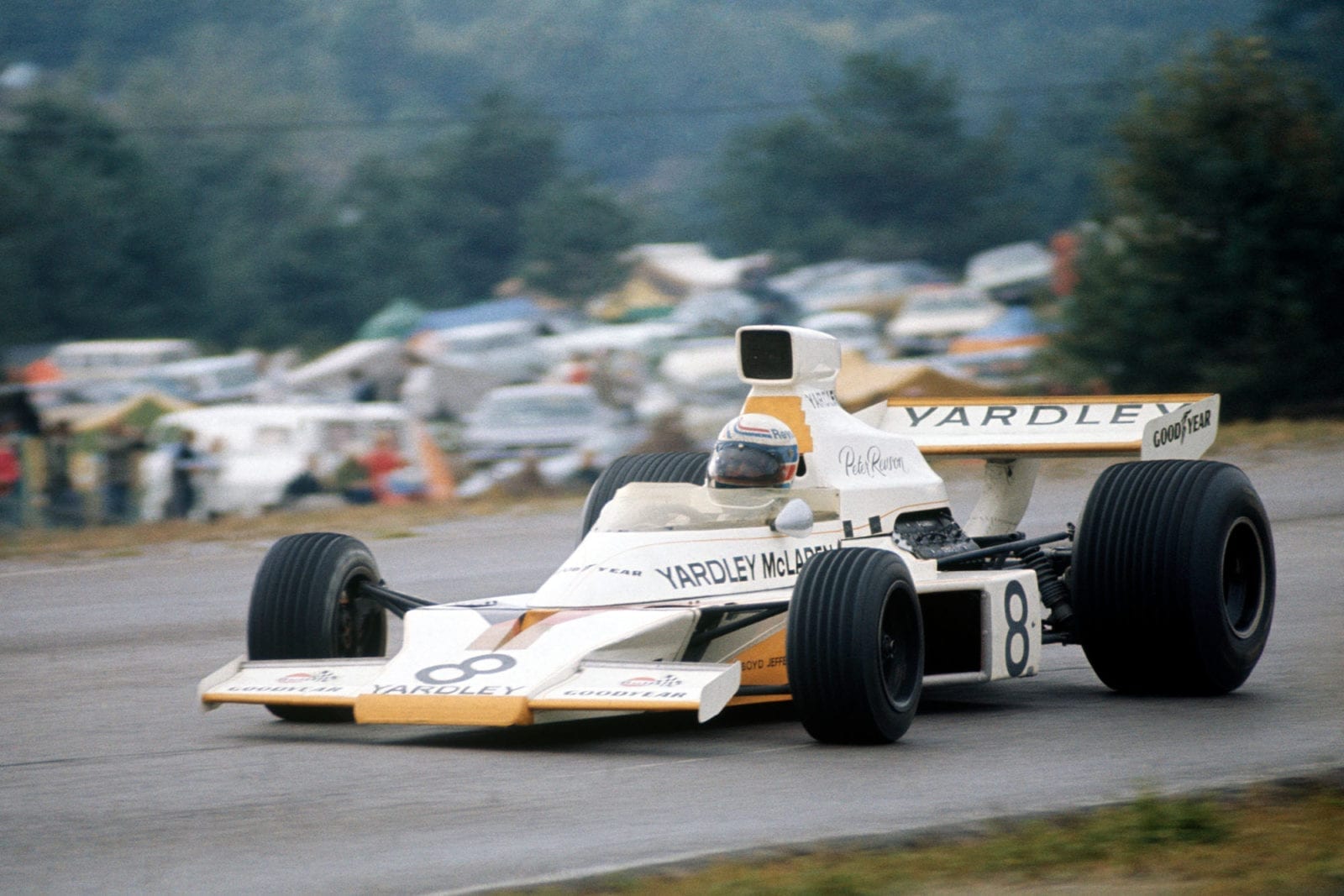
Peter Revson took his second win for McLaren at Mosport Park
Motorsport Images
Revson beats the confusion
Toronto, September 23rd
Critics of rallying will always tell you that the trouble with that particular branch of motor sport is that often one has to wait hours to find out who won; when the result is announced it is often contested and, even then, because of timing error, or other factors, the wrong man can easily take the honours. These anti-rally people will tell you that in Grand Prix racing it is very different. Everyone can see who the winner is because he receives the chequered flag at the end. Everything is crystal clear with the organisation and the competing teams knowing exactly where each competitor is lying, thanks to that marvel of science — the lap chart.
Then came the Canadian Grand Prix at Mosport Park with a chapter of incidents, including a complete foul up with the pace-car, that can do absolutely nothing to enhance the reputation of Grand Prix racing. Peter Revson was finally declared the winner and the various post-mortems would indicate that he definitely was first on the road. But let it be said that it was a lucky win thanks mainly to the pace-car being wrongly positioned — a great start for the new CSI/GPDA safety measure — his victory in front of Emerson Fittipaldi by half a lap would certainly have been the reverse had the pace-car been properly positioned. But more of that later.
It all started quite normally at the Mosport Park circuit some 50 miles from Toronto in rural Canada. The track is set in a very hilly and sandy terrain and as usual there were complaints about the bumpy nature of the circuit which suffers from the Canadian winter and, into the bargain does not receive as much maintenance as it should because of a lack of finance. The present promoters do not intend to go broke like the earlier ones so spend their money carefully, but a huge Can-Am crowd in June ensured the track’s viability for another year even though the Grand Prix had an attendance of only 40,000, as the weather deterred many potential race fans.
From the spectators’ point of view the facilities are limited, rustic would be a better word, but many come and stay the weekend in their mobile homes, so are self-contained, and many more camp. There is great fun to he had on the loose tracks which weave in and around the circuit and many of the fans bring along their trail motorcycles or off-road specials and enjoy the challenge of the rough terrain. The organisers provide free firewood and water and it is pleasant to see, unlike Watkins Glen, that everyone manages to co-exist without scuffling or even getting more than slightly drunk. The circuit itself offers some superb vantage points, great swooping downhill and uphill bends, which can be viewed from so many interesting angles — in many was some of the spots are similar to the Nurburgring, there aren’t so many of them, of course, and you know the circuit hasn’t the same challenge, but the cars come round much more quickly.
In the paddock there was plenty to discuss, even before practice was under way. For a start there was Regazzoni standing in his “civvies” looking somewhat dejected, with a very English tweed cloth cap pulled down over his forehead. He had flown out with the BRM team, the other drivers and mechanics, only to be told when he arrived that he was “the reserve driver”. This was not a very subtle way to say that he was OUT and that Peter Gethin who was out at the end of last year was back IN. Certainly Regazzoni has failed to show the promise this year which put his BRM on pole position in Argentina. His performances have been below par and one can even see the reasoning for dropping him. But what kind of mind makes such a fundamental decision so late in the day and then refuses to tell even the person concerned the reason or officially inform or consult its major sponsors? How can one expect a team run in this manner to achieve any kind of success?
Anyway, the Marlboro-BRM team brought along the three surviving P160E’s with no modifications, as a new model is well on the way, and the drivers were Niki Lauda, Jean-Pierre Beltoise and a somewhat confused Peter Gethin, who didn’t want to get involved in the politics but was very happy to be driving a Grand Prix car again. After a few laps Gethin confided that in the year sinee he last drove a BRM they don’t appear to have any more power, don’t handle any differently but do brake better. The only other non-Cosworth powered car was Arturo Merzario’s Ferrari 312B3 in the latest trim, no spare car being available.
There was interest in the Elf-Team Tyrrell camp with the inclusion in the third car, alongside Jackie Stewart and Francois Cevert. of Chris Amon. After his dismal, yet financially rewarding season with Tecno, the New Zealander needed a break. Here was his chance to prove that he still has the talent to put him in the class the media like to call “superstars”. While Tyrrell’s two regular drivers used the 006 models Anton took over the chisel-nose development car, 005. In fact, on the first day of practice, Stewart had his car in this same side-radiator trim but soon switched back to the normal set-up.
Despite stories of the Chapman/Fittipaldi split in the popular press following Monza, everyone seemed happy in the John Player Team Lotus camp. There was no change to the three Lotus 72’s, the spare car again carrying Peterson’s name on the side.
Like Elf-Team Tyrrell, McLaren were up to three car strength, bringing back Jody Schcckter for the first time since Silverstone. Since then the young South African had been in America and won the lucrative L & M Formula 5000 series. His McLaren was the one in which Revson won the British GP and carried the number (or zero as the Americans call it) — the same number, if it is a number, which is on the side of Scheckter’s Formula 5000 and Can-Am cars. Revson and HuIme had respectively M23/4 and M23/1.
The Motor Racing Developments team brought along three of their four Brabham BT42s, all with new and much larger air intakes for the Cosworth engines. All three also had a wing of the same type that Reutemann has been running for several races. This is an adaptation of the wing design used by Dan Gurney on his Eagles. The unusual shape is the work of Dr Bob Liebeck, who is senior engineer in aerodynamics research at McDonnell Douglas Aircraft. Although it is yet to be tried on an aircraft, Liebeck claims that this new aerofoil section, with its high leading edge, and deep curve, breaks new ground when it comes to high lift/low drag factors. Gordon Murray of the Brabham team was the first Formula One designer to cotton on to this, although we can expect the shape to become the vogue in a matter of months. The Brabhams were driven by Carlos Reutemann, Wilson Fittipaldi and Rolf Stornmelen, still standing in for Andrea de Adamich.
There was little to report in the Surtees canto with Mike Hai’wood and Carlos Pace in their usual blue and white TS14s while the assorted March 731s were handled by James Hunt, Jean-Pierre Jarier and Mike Beuttler. Now that Hesketh’s designer Harvey Postlewaite is working on his own car for next season, the white March has remained undamaged, although it had to be rebuilt around a new monocoque section in quite a hurry, following the Monza accident.
The Shadow team were looking for a good performance now that they were on the same continent as their generous sponsor, Universal Oil Products, and brought along two cars for Oliver and Follmer. Oliver’s car was the latest one with the revised rear suspension and extended wheelbase and the team seemed in good shape, particularly as both the drivers know the circuit well. There was a last minute plan to bring the third car out for Brian Redman but this was foiled when cargo space proved elusive. Graham Hill, however, had the red and white Embassy Racing example.
Finally there was the Iso Marlboro team plus von Opel’s Ensign, to complete the entry list, with not a Canadian in sight. Frank Williams’s once again had a change in his driver line-up with Howden Ganley’s latest team-mate being Tim Schenken, who hasn’t raced in Formula One since he drove his last race for Surtees at Watkins Glen a year ago. Since then Schenken had been waiting for Rondel to complete their own Formula One car, but the project is currently held up due to lack of finance. The two Williams cars had various detail changes suggested by Ron Tauranac, although the former Brabham designer wasn’t in attendance.
Qualifying
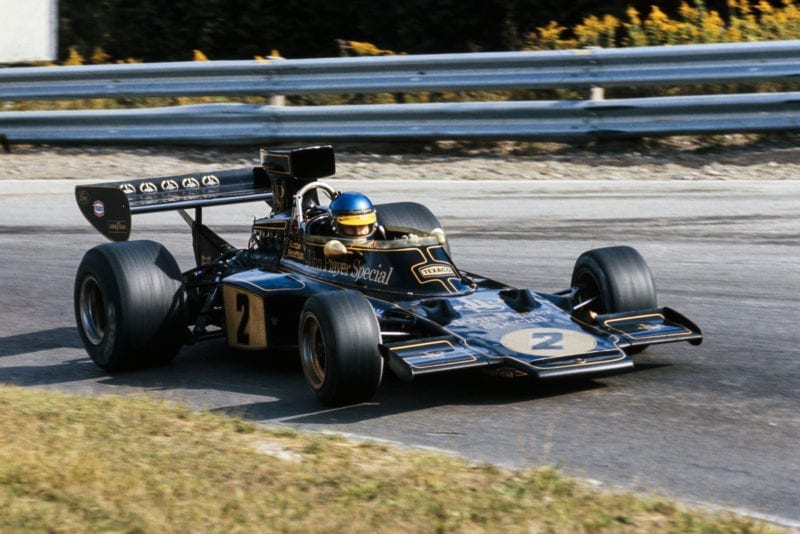
Ronnie Peterson took pole for Lotus
Motorsport images
Practice was scheduled for two sessions on both Friday and Saturday, although a repeat dose of the fog that held up last year’s race at Mosport delayed Saturday’s practice and left the track damp until the last half hour. Possibly this was the reason that last year’s pole position time of 1 min. 13.6 sec. was never equalled, and only approached by Peterson who was a full second faster than the rest.
In the first Friday session only the Swede broke into the 1 min. 14 sec. bracket with 1 min. 14.6 sec. The only other driver who seemed to be trying his utmost was Carlos Reutemann. The Argentinian was very spectacular, yet consistently fast, and finished up second fastest at 1 min. 15.5 sec. Jody Scheckter showed that he had not forgotten how to handle a Formula One car by recording third fastest time at 1 min. 15.7 sec. while team-mate Revson and Cevert did 1 min. 15.8 sec.
Arturo Merzario had a huge moment when the Ferrari got away from him into the tricky Turn 3 and careered through two catch fences, which managed to rip off most of the bodywork and deformable structures but leave the chassis remarkably undamaged. However the front suspension was badly twisted and the Italian had to sit out the second session. Hulme was in trouble when his gearbox chewed itself up and Stewart also had various problems, Gethin had a mis-fire and Oliver’s clutch packed up.
In session two on Friday afternoon most of the drivers started to settle down and the times started to come down. Peterson was again showing his superiority when it comes to turning a pole position lap and he finished up with a superb 1 min. 13.69 sec, Peter Revson enjoys Mosport and his best lap of 1 min 14.73 sec. made him second fastest just fractionally quicker than Scheckter at 1 min. 14.76 sec. Reutemann was still up there too with a best of 1 min. 14.81 sec. These four times remained unbeaten throughout Saturday so Peterson was on pole position for the eighth time in 14 races. Fifth fastest on Friday was the Austrian Niki Lauda, underlining that while his climb up the ladder has been relatively unspectacular compared with the Scheekters of this world, skill and determination is most certainly there.
On Saturday, as we said, the fog held up proceedings and the track was soaking wet. Finally, two hours late, the cars were allowed out singly to do four laps each, more to keep the crowd happy than anything else. While this was going on the track was drying quickly and, in the space of half an hour the damp Ontario fog lifted completely. Sp the session finally got underway with two and a half hours available for the rest to knock Peterson off pole position. There wasn’t much chance of that with the track still damp in places and, anyway, when it did finally dry out Peterson was fastest again with a time of 1 min. 14.59 sec. Emerson Fittipaldi came nearest with 1 min. 15.03 sec. which boosted him to fifth place on the grid. Cevert was again going well and lowered his time to 1 min. 15.12 sec. to share row three with Fittipaldi.
Denny Hulme was also much happier on Saturday and he improved to 1 min. 15.32 sec. to make row four with Lauda, who had failed to improve. Jackie Stewart was an unaccustomed ninth on the grid alongside Wilson Fittipaldi, who was very happy with his Brabham. Chris Amon settled in well with the Tyrrell team, but set no records so was on row six with Mike Hailwood, the two Shadows of Follmer and Oliver were on row seven while Hunt and Beltoise filled row eight Hunt taking it carefully in the rebuilt car. The rest were as shown on the grid with Graham Hill looking faster than he has all season.
Race
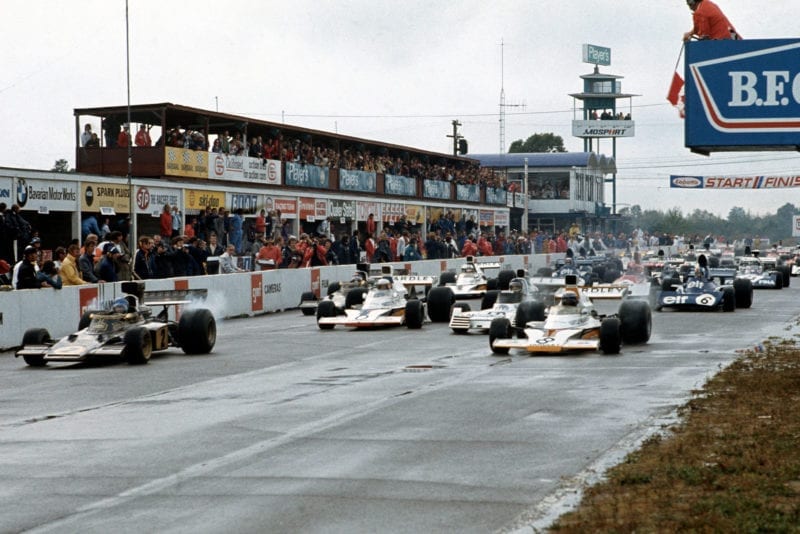
The cars tentatively pull away on a wet race track
Motorsport Images
Sunday was cold, miserable and wet typical Canadian GP weather in fact although fortunately the fog was absent. The morning warm-up session on the sodden track caught out several drivers, including Peterson, who was having a quick try in his spare car. The Swede hit the Armco at the corner in front of the pits and dented the front of the car quite severely (by late evening it was stripped down to the bare chassis ready to be sent back to England for a repair to be effected). Hunt, Beltoise, Pace and von Opel also had brushes with guard rails although all were repaired in time for the race. The Ensign, however, had its “batmobile” tail section damaged and had to race with only the side sections.
Rain continued to drip down all morning but as the drivers set off on the parade lap in a string of Porsche 914s, the heavens opened and drenched everyone. Once back at their racing cars, with the shower over, the drivers were allowed three exploratory laps before lining up on the grid.
The Canadian flag finally fell half an hour late, with the very cramped field all making it into the first corner safely in a great shower of spray. Everyone had plumped for full wet weather tyres except Beltoise, who had “intermediates” fitted in the hope the track would dry out. Great things were expected of the BRMs in these conditions, for Firestone have a lead in wet weather tyres and Lauda had proved unbeatable in the wet session in Holland earlier in the year.
At the end of the first lap it was Peterson in the lead followed by Scheckter, but with Lauda already third, Fittipaldi was fourth, Stewart was up to fifth ahead of Reutemann, Revson, Cevert, Oliver, Wilson Fittipaldi, Hunt, Pace and the rest.
The man to watch was definitely Lauda, his bright red helmet proving easy to spot amidst all the spray and, at the start of lap three he squeezed by Scheckter going into Turn 1 to grab second place and, a lap later, he was in the lead of a Grand Prix for the first time in his career. Two laps later he had an eight second advantage and, by lap ten, he was over a quarter of a minute in the lead and had lapped the last eight runners. His superiority in the wet was remarkable and, while we all know that BRM and the Firestone tyres suited the conditions, Lauda deserves a great deal of praise too.
Behind him Peterson and Scheckter were trading second place while Stewart and Fittipaldi had been fighting for fourth spot, although now they suddenly had Pace in their midst. Oliver was also revelling in the conditions and had moved up to seventh place, while, already, there had been countless spins.
Hulme, who is currently wittering about banning Grand Prix racing in the rain, was at the back of the field after a second lap puncture and Merzario was last after knocking the front wing askew on the second lap. He came in for a new nose cowling but one wasn’t available so he was sent out without a nose section at all. Peter Gethin’s return to BRM lasted only five laps before the engine lost its oil pressure and he was the first retirement. Apart from the fact that Lauda held a commanding, and ever increasing lead at the front of the field, the positions behind chopped and changed almost very lap, although the circuit was already showing signs that it was drying very quickly. By lap 15 Peterson seemed to be reasonably firmly in second place with Fittipaldi third and Pace fourth having just overtaken Scheckter. Oliver was sixth, while a spin had dropped Stewart behind Cevert. Reutemann was ninth leading Schenken, Hunt, Ganley and HaiIwood. The rest had all been lapped and were led by Revson and Amon.
From then on the action kept coming. First Peterson “lost it”, bounced up a kerb, and hit the Armco. The damage was slight and he continued a couple of hundred yards before he realised that the rear suspension was broken, so he stopped. Oliver meanwhile had overtaken Scheckter and Pace, so was up to third position.
On lap 18 Pace really started something by roaring into the pits yelling for dry weather tyres. The track had dried so quickly that it was ripping the chunky wet weather tyres to pieces. On lap 20 Lauda followed suit but was sent out on “intermediates” still in eighth place. Fittipaldi now led from Oliver, Cevert, Scheckter then Stewart. Ganley had put on a spurt and was sixth ahead of Reutemann, Lauda, Revson, Amon and the rest.
From then on pit stop followed pit stop although Fittipaldi kept out in front for the next ten laps with Oliver second about fifteen seconds behind. Through all this Beltoise was climbing up the field rapidly, his “intermediates” proving just the job. Revson hadn’t stopped either and was charging up those lap charts which were still in some semblance of order while Lauda quickly made up places.
Second man Oliver stopped for his tyre change on lap 31, Fittipaldi on lap 32 and so did Stewart, but, for once, the Tyrrell efficiency was not evident. Fittipaldi’s stop was a long one for the suspension settings were altered. Oliver’s stop was quite quick. Once the former leaders were back in the race and various other people had roared in and out of the pits, absolutely everyone’s lap chart, including the organiser’s, had “blown up”. Just to add to all the confusion Scheckter and Cevert, who were now on wet weather tyres, had a coming together on Turn 2. The Frenchman’s car charged the Armco harrier head-on and he was lucky to escape without a broken ankle at least, for the pedal mounting was twisted up at 90 degrees. Just to prove he was okay he started to chase Scheckter down the track in a bid to thump him. The general consensus of opinion was that Scheckter was to blame for the accident. Fortunately Cevert was restrained by marshals and he suddenly found his leg hurt rather a lot.
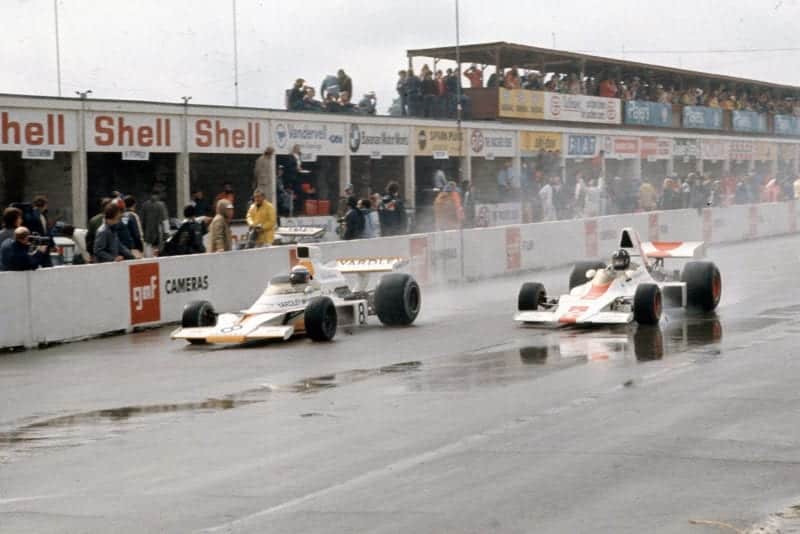
Hulme passes Hill into the first corner
Motorsport Images
At the Canadian Grand Prix they have always been rather fond of sending ambulances out on the course even if a driver isn’t seriously injured. Thus two ambulances and a breakdown truck were despatched. Under the new rules, brought in after the Zandvoort tragedy, if such a vehicle is on the track then the pace-car must be sent out in front of the leading car to slow the field down, until the track is clear again.
But no one had anticipated that this would be a difficult task if the organisers weren’t really sure who was in the lead. Most people reckoned Oliver was first despite his pit stop, the officials however, for some unknown reason, nominated Ganley who definitely wasn’t. Hours after the race, a lap chart was constructed from the lap time of every driver on every lap and this showed that Beltoise was actually in the lead. Motor Sport’s lap chart was confused at this stage but it would suggest that this was not the case, and that Oliver was in front and not second as the official chart suggests.
Whatever the true order was the pace-car, with Peter Mackintosh of the Formula One Constructors’ Association aboard, waved Ganley in behind and everyone started to crowd up behind. Of course those drivers just ahead of Ganley were able to carry on at racing speed for two or three more laps and catch up the back of the crocodile, thus making up almost a complete lap. Revson was one of them, for he had just scorched out of the pits following a late tyre change and, Possibly, the quickest of the race. The other lucky chap was Oliver and both joined the end of the queue. Emerson Fittipaldi, however, was just behind Ganley so had to get in line and thus, effectively, lost the race. While all this was happening Beltoise made his nit stop, the last driver to do so.
After ten laps of this, during which Cevert’s wreck had been dragged from its rather dangerous resting place, the race was suddenly on again and the track was completely dry. Ganley decided that as someone thought that he was in the lead he had better drive like a race winner. The result was fantastic and the New Zealander gave a tremendous demonstration holding off Stewart and Fittipaldi for eight laps, driving the race of his life, and taking the Williams car round three seconds a lap quicker than in practice.
Meanwhile Oliver had, apparently, passed Beltoise for the lead and so did Revson although Oliver was pulling away from the American. Everyone in the pits was sure the Shadow was leading, the first time any Shadow has ever led a motor race, but most thought Fittipaldi was second. The Brazilian soon passed Stewart and was intent on making up a complete lap on Oliver. Beuttler had retired with his engine blown up but the rest were still going strongly.
The lap chart, issued later by the organisers, shows that Revson took the lead from Oliver on lap 46. This in fact would seem to be correct for that was the lap in which the Romford lad slowed almost to a stop as he passed the pits due to blocked throttle slides. He got going again but apparently that was when Revson slipped by and so did Beltoise, but, as far as the commentator and everyone at the race was concerned, Oliver was still in the lead with Fittipaldi driving a fantastic race in second place to make up that lost lap.
With about ten laps to go the excitement was reaching a peak and it looked as if Fittipaldi might just catch Oliver. Most pit boards, including McLaren’s were showing Revson third, while the general opinion was that Beltoise was fourth with Stewart fifth and Ganley sixth.
With four laps to go Oliver still had Fittipaldi behind him but closing, and the pair came up behind Beltoise who wasn’t going to let either of them by if he could help it. He certainly didn’t know he was officially second and defending that position from them but such was this race. With two laps to go Fittipaldi passed Oliver and the pair of them passed Beltoise.
Everyone craned their necks for the last lap and as Fittipaldi flashed across the finish line Colin Chapman flung his hat in the air. But the man with the flag didn’t move. Half a lap later he suddenly waved it at a group of cars and it looked as if Ganley was actually given the chequered flag first but, apparently, it was meant for Revson although, by this stage, he had 81 laps officially to his credit.
Revson was provisionally given the victory garland and everyone looked extremely confused. Most people plainly didn’t believe the result. Three hours later the timekeepers had unravelled the times for every car on every lap and constructed a lap chart from it which confirmed Revson was, indeed, the winner. This would appear to be the correct decision and the result looks about right although personally I wonder about Beltoise. The official chart shows him making a pit stop without losing a place.
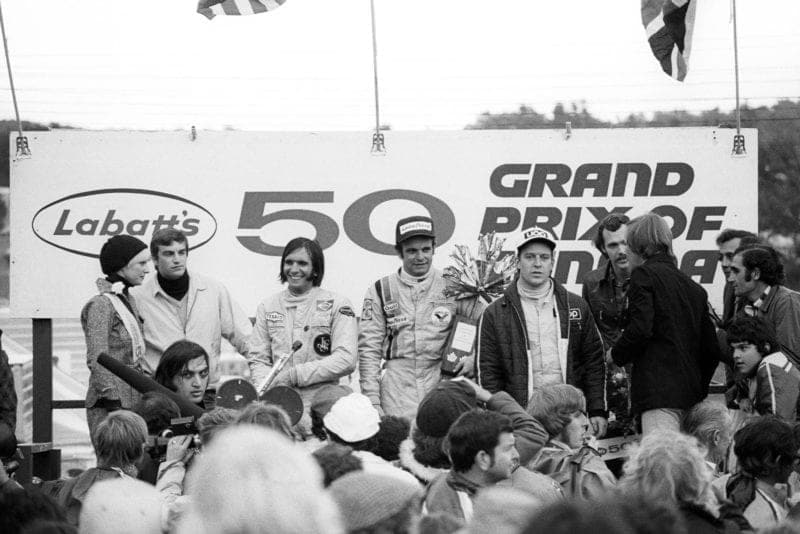
Revson celebrates on the podium
Motorsport Images
However there is no doubt that Fittipaldi was the moral victor of the race and that the wrong positioning of the pace-car lost him the race. Lauda sadly retired 18 laps from the end with a broken gearbox and Pace eight laps from the end with a broken wheel. Ganley’s drive in the second part of the race is well worth remembering as is Lauda’s dominance of the race when it was wet.
So there you have one of the strangest and the most controversial Grand Prix in the eight-year history of the current 3-litre Formula One. — A.R.M.
